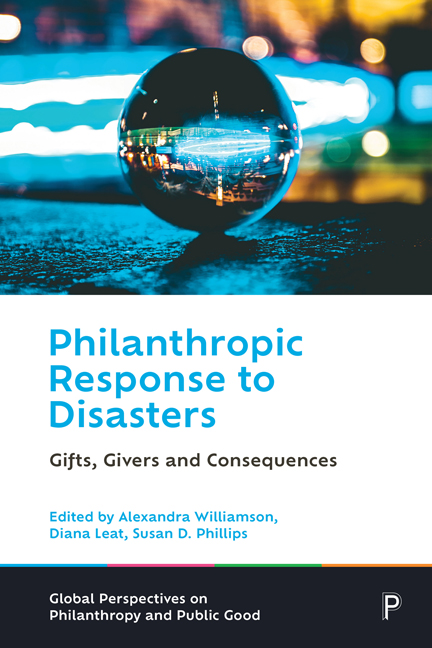Book contents
- Frontmatter
- Contents
- List of tables and figures
- Notes on contributors
- Series editors’ preface
- 1 Introduction
- 2 The public’s philanthropic response to disaster: plus ça change?
- 3 Disaster fundraising: readiness matters
- 4 Roles of philanthropic foundations as funders and distribution agents in disaster response
- 5 The private sector and disasters: from reactive response to disaster resilience
- 6 Fundraising, grantmaking and regulatory issues: regulating good in bad times
- 7 Doing good better: public policy for disaster philanthropy
- 8 Philanthropy’s place in community-based capacity development for disaster resilience
- 9 Nonprofit collaboration and coordination in disaster response: lessons from the 11 September recovery
- 10 The promise and reality of philanthropy in disasters
- 11 Conclusions and looking forward
- Index
7 - Doing good better: public policy for disaster philanthropy
Published online by Cambridge University Press: 17 January 2024
- Frontmatter
- Contents
- List of tables and figures
- Notes on contributors
- Series editors’ preface
- 1 Introduction
- 2 The public’s philanthropic response to disaster: plus ça change?
- 3 Disaster fundraising: readiness matters
- 4 Roles of philanthropic foundations as funders and distribution agents in disaster response
- 5 The private sector and disasters: from reactive response to disaster resilience
- 6 Fundraising, grantmaking and regulatory issues: regulating good in bad times
- 7 Doing good better: public policy for disaster philanthropy
- 8 Philanthropy’s place in community-based capacity development for disaster resilience
- 9 Nonprofit collaboration and coordination in disaster response: lessons from the 11 September recovery
- 10 The promise and reality of philanthropy in disasters
- 11 Conclusions and looking forward
- Index
Summary
Philanthropy has become an integral component of disaster assistance, complementing the roles of government. In financial terms, the combined contributions of individuals, foundations and corporations are impressive. Among donating households worldwide, 41 per cent give in response to natural disasters (Double the Donation, 2022). Crowdfunding has accelerated the speed and magnitude of giving, as demonstrated by the success of entertainer Celeste Barber in raising over $50 million in a few days from people in more than 75 countries for those affected by the Australian bushfires of 2019– 20 (McGregor-Lowndes, this volume). In the early days of COVID-19, Captain Tom Moore ‘inspired’ others in the UK (and beyond) by attempting to walk 100 laps of his garden before his impending 100th birthday, with the goal of raising L1,000 for the government National Health Service (NHS). He ultimately raised L32 million (Pidd, 2021), although the foundation created by these donations has come under investigation by the charity regulator (BBC, 2022). Over the second year of COVID-19, global donations from foundations, corporations and high net worth (HNW) individuals to address the global pandemic topped over $20 billion, eclipsing giving to all other previous crises (Candid and CDP, 2021).
While philanthropy is not – and should not pretend to be – a substitute for government funding and action in times of disasters, it offers some distinctive advantages over governments, as well as benefits to donors and those affected by disasters. Funds can be raised rapidly on an international scale, often without negotiation of jurisdictional boundaries or political considerations. Disbursements can be directed to local organisations to facilitate community-specific and place-sensitive responses. Donations may have few restrictions on their use and can facilitate risk-taking in a way that governments cannot. For donors, giving enables expression of shared grief and loss (McLean and Johnes, 1999), and produces a ‘warm glow’ that has a positive spillover effect on other giving, lifting rather than detracting from donations to other causes (Brown et al, 2012; Rooney, 2017; Scharf et al, 2021). It can enhance social capital with community-driven action (Xiang et al, 2021), thus contributing to longer-term organisational and community resilience. Corporate support and engagement with local business has been shown to restore market functioning and help local economies bounce back following a disaster more quickly than can government intervention (Ballesteros et al, 2017).
- Type
- Chapter
- Information
- Philanthropic Response to DisastersGifts, Givers and Consequences, pp. 133 - 164Publisher: Bristol University PressPrint publication year: 2023



